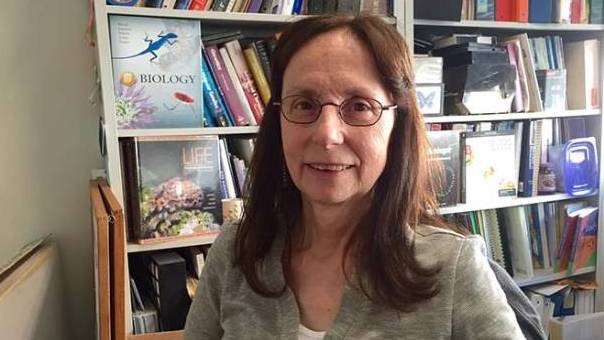
Inside a lab at Santa Monica College, students are busy conducting another experiment. Using a sophisticated chain reaction machine, they have grown mammalian cells under controlled conditions and are checking what proteins they produce.
SMC’s Life Sciences department dispels the notion that a community college education consists of only lectures in a crowded auditorium. Here, students work on the latest equipment: compound microscopes, digital spectrophotometers, fluorescence microscopes…you get the picture. One of the people whose work and vision have created this culture of excellence is Life Sciences professor Mary Colavito.
“At SMC, being innovative in your teaching methods is highly valued, and developing new curriculum is well-prized,” says Mary, who has taught biology to both biology majors and non-majors at SMC for 25 years.
“There are really no barriers,” adds Mary – she was drawn to SMC because it was an open access institution. “Someone who may not even be able to gain admission to another institution can come in and excel in our program.”
Mary, whose original aspiration had been to attend medical school, spent a summer as an undergrad student on the surgical floor of a hospital. Luckily for SMC, she found it less rewarding than helping students solve calculus problems on a chalkboard in the math lab.
Mary went on to earn an M.S. degree and a Ph.D in Biology, both from the University of Rochester.
Early on, Mary realized that in the rapidly changing field of life sciences, some of the most valuable knowledge is learned not in the classroom or between the covers of a book, but inside a lab. Three years ago, she was instrumental in helping to write a grant proposal to secure a $5.8 million grant from the U.S. Department of Education to establish a STEM program at SMC that promotes the study of Science, Technology, Math and Engineering among underrepresented minority students.
The program – which Mary helped design and incorporate into the college’s curriculum – helps students complete their studies at SMC, then transfer to a four-year research-oriented program. It also offers a one-week crash course and residency at UCLA and paid internships to spend ten weeks at the university’s labs.
“We think that students becoming involved in research is key to their success in the sciences, and so we envisioned having courses that would introduce them to the research process and train them in some research methods,” she said. Mary helped design two research courses for SMC’s Science and Research Initiative – including a cellular and molecular biology research methods class.
“Mary is one of the most valuable members of the Life Sciences Department, as well as Santa Monica College as a whole,” says Garen Baghdasarian, Life Sciences Department Chair. “She is admired and respected by her colleagues, and in my opinion, is a model academician.”
Over the years, Mary has had students contact her with their success stories – there’s the professor of chemistry at UC Santa Barbara, and the transplant surgeon who went on from SMC to medical school at UC San Francisco.
Mary’s fondest SMC memory is of the day the Science Building was dedicated – she even remembers the exact date (October 5, 1999) – and how excited students were about what the new building and its capabilities would mean for their pursuit of science.
“I see my students’ experience here as part of a continuum of their growth,” says Mary. “I’m just a brief influence on their path, and maybe I can help them acquire knowledge – but it’s much better if I can help them acquire skills for success.”
Caring, compassionate, inspiring, natural leader, innovator –these are just a few of the superlatives her colleagues use to describe Mary. Judging by her legacy, they’re right on point.



